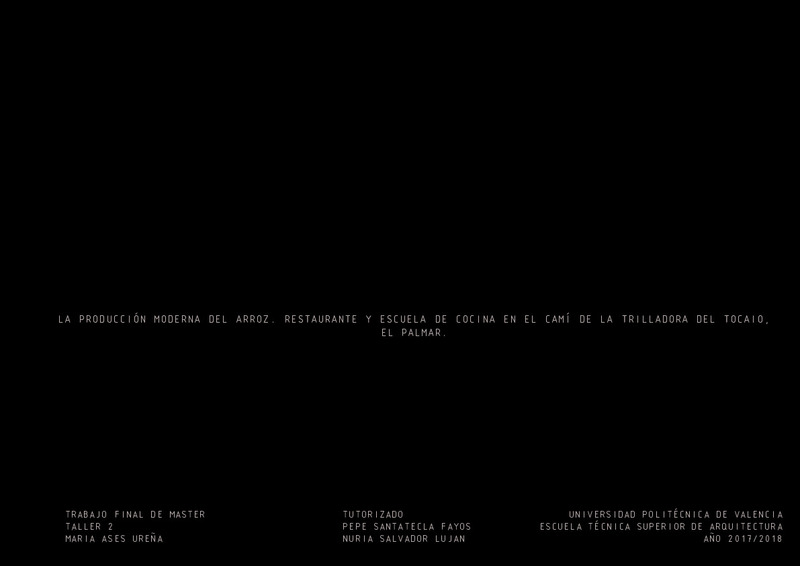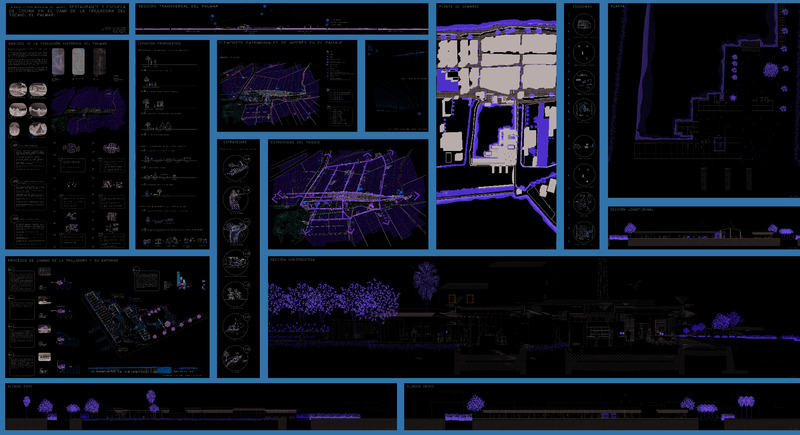JavaScript is disabled for your browser. Some features of this site may not work without it.
Buscar en RiuNet
Listar
Mi cuenta
Estadísticas
Ayuda RiuNet
Admin. UPV
La producción moderna del arroz. Restaurante y escuela de cocina en el camí de la Trilladora del Tocaio, el Palmar
Mostrar el registro sencillo del ítem
Ficheros en el ítem
| dc.contributor.advisor | Santatecla Fayos, José
|
es_ES |
| dc.contributor.advisor | Salvador Luján, Nuria
|
es_ES |
| dc.contributor.author | Ases Ureña, María
|
es_ES |
| dc.coverage.spatial | east=-0.3182602; north=39.3116286; name=Camí de la Trilladora del Tocaio, el Palmar, Valencia, Espanya | es_ES |
| dc.date.accessioned | 2020-01-24T11:01:32Z | |
| dc.date.available | 2020-01-24T11:01:32Z | |
| dc.date.created | 2018-09-24 | |
| dc.date.issued | 2020-01-24 | es_ES |
| dc.identifier.uri | http://hdl.handle.net/10251/135483 | |
| dc.description.abstract | [ES] Solo después de elegir el lugar donde se va a construir un edificio, es cuando se es consciente realmente de la importancia sustancial que tiene el modo en el que se va a percibir. Establecer la arquitectura en un punto en concreto denota el significado de éste y en algunos casos lo revaloriza. Partiendo de su propia historia y de la evolución que ha sufrido el paisaje, se pretende recuperar la esencia de la isla del Palmar de manera que se crean cinco identidades a lo largo del pueblo que recuerden y definan la historia y aquellas actividades que eran propias del lugar. Es por ello que el proyecto trata de subrayar los recursos propios que hacen tan característico el paisaje del Palmar, mientras potencia el significado de los edificios históricos del entorno, gracias a la elaboración y estudio del producto estrella, el arroz. El emplazamiento del proyecto del restaurante y la escuela de cocina se configura entorno a la Noria, el embarcadero principal, la Trilladora del Tocaio con el sequer y una de las casetas de un grupo sindical en defensa de los pescadores. Es aquí donde arquitectura, paisaje y personas se encuentran en consonancia y son causa y efecto de la emoción. | es_ES |
| dc.description.abstract | [EN] Only after choosing the place where a building is going to be built, is it really aware of the substantial importance of the way in which it is going to be perceived. Establishing the architecture at a specific point indicate the meaning of it and in some cases it revalues ​​it. Starting from its own history and the evolution that the landscape has undergone, it is intended to recover the essence of Palmar Island in such a way that five identities are created throughout the town that remember and define history and those activities that were typical of the place. That is why the project tries to underline the resources that make the landscape of Palmar so characteristic, while enhancing the meaning of the historical buildings of the surroundings, thanks to the elaboration and study of the star product, rice. The location of the project of the restaurant and the cooking school is configured around the Noria, the main pier, the Trilladora del Tocaio with the sequer and one of the booths of a trade union group in defense of the fishermen. It is here where architecture, landscape and people are in consonance and are the cause and effect of emotion. | es_ES |
| dc.language | Español | es_ES |
| dc.publisher | Universitat Politècnica de València | es_ES |
| dc.rights | Reserva de todos los derechos | es_ES |
| dc.subject | Paisaje | es_ES |
| dc.subject | Arquitectura | es_ES |
| dc.subject | Personas | es_ES |
| dc.subject | El Palmar | es_ES |
| dc.subject | Arroz. | es_ES |
| dc.subject | Landscape | es_ES |
| dc.subject | Architecture | es_ES |
| dc.subject | People | es_ES |
| dc.subject | Rice. | es_ES |
| dc.subject.classification | PROYECTOS ARQUITECTONICOS | es_ES |
| dc.subject.other | Máster Universitario en Arquitectura-Màster Universitari en Arquitectura | es_ES |
| dc.title | La producción moderna del arroz. Restaurante y escuela de cocina en el camí de la Trilladora del Tocaio, el Palmar | es_ES |
| dc.type | Tesis de máster | es_ES |
| dc.rights.accessRights | Abierto | es_ES |
| dc.description.bibliographicCitation | Ases Ureña, M. (2018). La producción moderna del arroz. Restaurante y escuela de cocina en el camí de la Trilladora del Tocaio, el Palmar. http://hdl.handle.net/10251/135483 | es_ES |
| dc.description.accrualMethod | TFGM | es_ES |
| dc.relation.pasarela | TFGM\89862 | es_ES |
Este ítem aparece en la(s) siguiente(s) colección(ones)
-
ETSA - Trabajos académicos [4687]
Escuela Técnica Superior de Arquitectura







